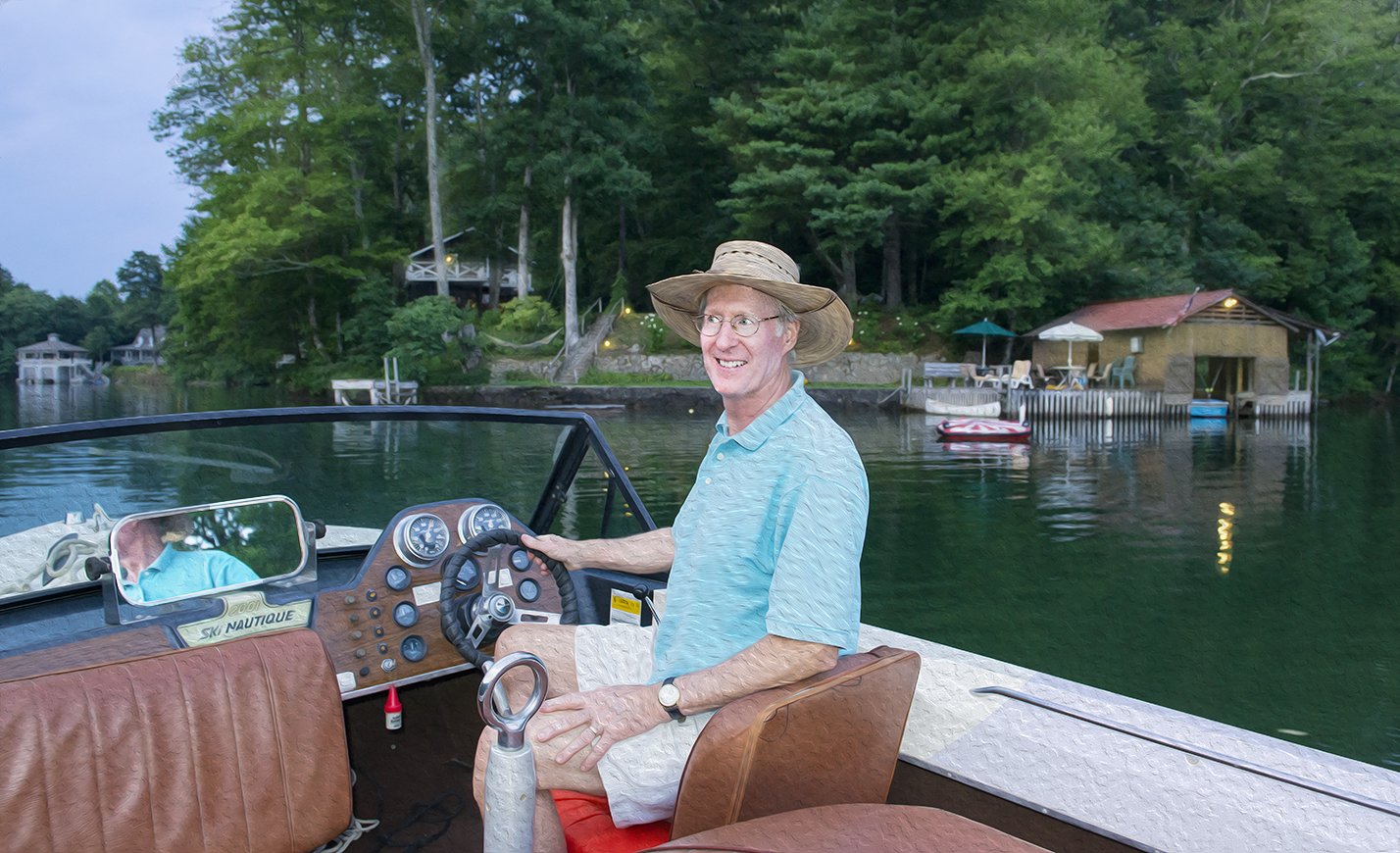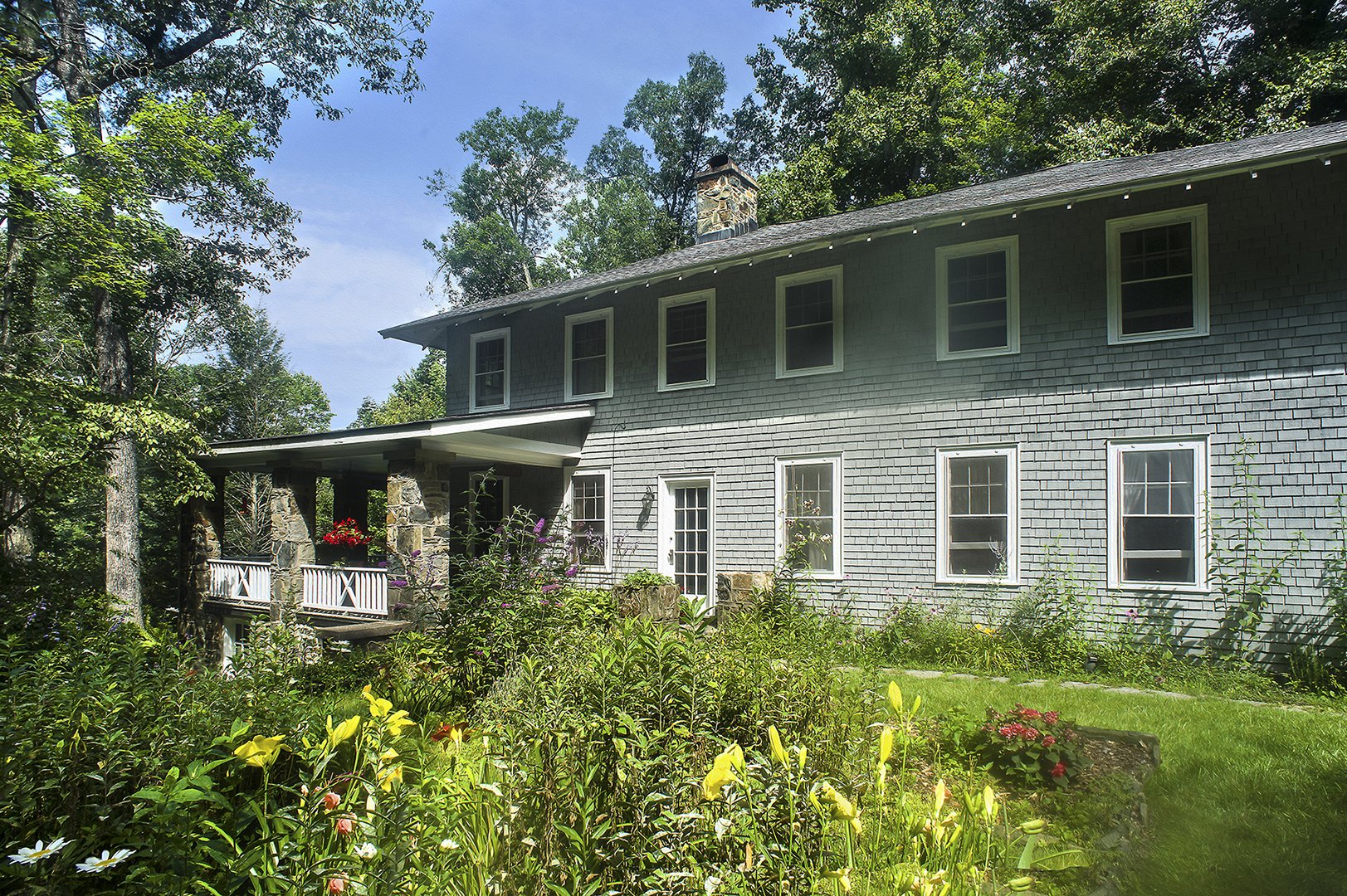Interlochen — The Law Family Lake Summit Retreat
/By Missy Craver Izard
(Part 2 of a two-article series. Read the first article here.)
As the new dam that would create Lake Summit neared completion in 1919, the wonderful new power source proved to be the beginning of many beloved family retreats on Lake Summit. Removed from the confusion of nearby towns and cities and accessible only by a dirt road, enjoying the tranquility of Lake Summit became a tradition for the Law and Montgomery families. Both families soon began work on their summer homes situated on adjacent parcels overlooking the southwest shore of the lake and joined by a common driveway.
John Adger Law with his Grandchildren Glenn Robertson and Polly Hill Woodham
“The Cotton Mill Fraternity was tight,” remembers Glenn Robertson, the son of Grace Law Robertson, the youngest child of John Adger Law and his wife, Pearl. “My grandmother, Pearl Sibley Law and Miss Bessie, Walter Montgomery’s wife, were best friends. They planned and developed their properties at the lake together on top of their own little hill. The houses were prefabricated and almost the same size with around 11 bedrooms. Timber was cut to the design specifics by Clement Lumber Company of Spartanburg and carried by rail to the north side of the lake where it was loaded on a barge and floated to the construction site.
In the early 1920s while the lake was filling up and the house was under construction, my mother and her whole family spent two summers living on a barge on the lake with access from the North Lake Summit Road. These were happy times for their family. Everyone was healthy. Everybody was together.”
“My grandparents, Granny and Demi, named our house, Interlochen, said Glen. Interlochen takes its name from the Latin word, inter, meaning between and the Scottish word, lochen, meaning lakes. Interlochen was built on a site that sits between the larger part of the lake and the largest cove on the south side; the land between the lakes.”
In 1989, Betty Moss, whose family bought Interlochen (the Law home) in 1969, had the opportunity to interview Glenn’s mother, Grace, and her friend Tillie Crow whose family owns a house next door to Interlochen. At 80 years old, Grace still played 18 holes of golf almost daily and recalled joyful memories of the property:
Law Grandchildren (Photo provided by Susan Woodham)
“This house was such a happy place for my family — people would visit, and all their worries disappeared. We always had a lot of company — we never knew who was coming for the weekend. I don’t remember if my mother had any help. I’ll tell you the primary way she fed us. She bought jelly by the case and soda crackers in the big cardboard boxes and that’s what we got. We had a pot of grits for breakfast and a pot of grits for supper. We never knew what we were going to have with them.”
“My father had cows down at our place at Saxon Mill. He would send a vat of milk on the train every morning to the Tuxedo Junction and the event of the day was for us to go to pick up the milk. We had an old truck and the man who owned the store in Tuxedo called our truck the “Lord Help Us…” He’d see us coming and he didn’t know whether we were coming through his store or not. That was the highlight of our day. We spent many hours in the evening sewing or talking with the women of the family or with the whole family playing musical instruments and singing around the big fireplace.”
“My cousins and I grew up on the lake during the war and the depression,” recalls Glenn. He continued: “Our families were insulated from the hardships of the world and immersed in the intimate community of the lake. Family members had the same bedroom every summer, each with a different knocker attached to the door. Every Sunday my grandfather, Demi, conducted a mandatory three-hour church service in the dining room. I grew up with the Morgan boys who were local and lived somewhere up in the woods behind our house. My grandmother was a true saint. She taught the Morgan boys how to build dry rock walls and supervised them in the building of the walls, pathways, and a rock picnic table that remains at Interlochen today. They taught me how to smoke camel cigarettes! I remember the day WWII ended — my cousin, Gabe Hill, loaded our canoe with pots and pans and we paddled all around the lake banging them to celebrate the end of the war.”
Polly Hill Woodham (Glenn’s first cousin and daughter of Margaret Law Hill) spent all her summers on Lake Summit. Her daughter Katherine Woodham shared stories from her mother, Polly, and her best friend, Lalage Oates Warrington, a Montgomery family member during their youth on Lake Summit:
Interlochen Today (Photo Nace Few)
“The two young girls spent days floating from one end of the lake to the other. When it was lunchtime, they would just stop at the nearest dock and eat lunch with the family that lived there and then keep going. There were only a few houses on the lake and no boathouses — just rafts or barges for docks and large beach areas. Everyone knew each other and every household played a part in raising the children on the lake. Miss Bessie Montgomery was crazy about children and loved having them at her home, Montaire. She had a beautiful Japanese garden that my mother, her cousins and the Montgomery children would run through on homemade stick horses pretending to be princesses in distress. There were apple trees planted along the lake near some of the camps. They would paddle their canoe over to the trees to pick apples. Sometimes a snake would fall from the trees into the boat. They would scoop it up with their paddle and release it back into the woods.”
—
It wasn’t long before others followed the Law and Montgomery families to the lake especially after John Law formed the Lake Summit Corporation and encircled the lake with its present public roadway. Most of the early lots were sold to friends in the textile industry in Spartanburg and Greenville. Eventually, a contingency of families from Florida arrived by way of the local summer camps.
“Lake Summit is a sacred place, said Glenn Robertson. I spent more time there than any other place I lived. I often feel sorry for people who did not grow up with a Lake Summit. After my grandmother died, our family held on to Interlochen as best as we could. It was sold to Walter Montgomery in 1960 for $35,000 and remained unoccupied for almost a decade. In 1969, Betty and Murphy Moss of New Orleans purchased Interlochen and a few acres from the original tract. Once again it held the promise of summer and a loving family within it.
Interlochen has now been in the Moss family for 55 years. When they first took ownership, the house had been vacant for a decade and needed attention both inside and out. It took a lot of muscle to restore the overgrown garden and uncover the beautiful stonework built by the Morgan boys and orchestrated by Pearl Law. Paint goes a long way to freshen up walls, ceilings, iron beds, and claw-footed bathtubs. Much of the Law furniture in the house and locally made bent twig rockers on the porch remain today. On a visit back to the house, Glenn said that the Moss family had kept the spirit of it.
Hal(left) and Melinda Way on July 4th at Interlochen
In 1990, Betty Moss renovated the servant’s quarters above the garage as a guesthouse. Windows were added, the roof was raised, the heart of pine floors were discovered, and reclaimed cypress from the old dam flume was used to add a deck. Now known as Nana’s nest, the space is used by a steady stream of houseguests and along with the house is the scene of many celebrations, reunions, and house parties.
Today, Interlochen is owned by Melinda Moss Way and her brother, Kevin Moss. When Melinda was a camper at Green Cove, her cabin was always thrilled to go for a swim and dinner on the porch. Melinda’s daughter, Courtney, also went to Green Cove and the rituals were repeated. After winterizing Interlochen, Melinda and her husband, Hal, retired and moved there year-round; beginning a new chapter in their lives and welcoming the third generation of the Moss family to the house.
Missy Craver Izard was born and raised in Charleston, S.C. and resides in Flat Rock, N.C , The Little Charleston of the Mountains A retired Summer Camp Director and art teacher, Missy is an entrepreneur, speaker, author, journalist, community leader, and the recipient of several awards including the White House Champions of Change.









